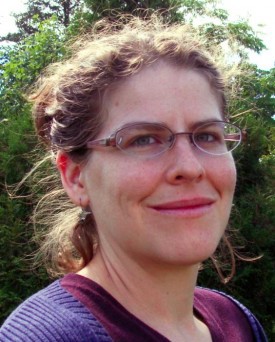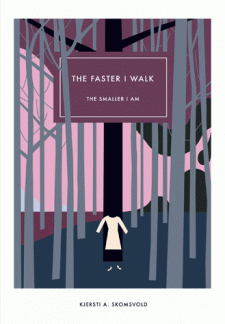Translating A Norwegian First Novel: A Q. & A. With Kerri Pierce
by Alicia Kennedy

“Awkward” is an overused word that has, over time, come to connote an almost endearing shyness. Its actual meanings, though — difficult, ungainly, abnormal — perfectly describe Mathea Martinsen, the narrator of Norwegian writer Kjersti A. Skomsvold’s debut novel, The Faster I Walk, The Smaller I Am. The book, out next week from Dalkey Archive, takes up Mathea’s life after the death of her husband. With no one to talk to, she wears a watch in the hopes that someone will ask her the time, talks to the news anchors on TV and repeatedly calls the operator asking for her own number. It’s a painfully funny exploration of loneliness, written in a lean prose that’s been translated from Norwegian into English by Kerri A. Pierce.
A prolific translator, Pierce works in seven languages — German, Danish, Dutch, Portuguese, Spanish, Norwegian, and Swedish — and is pursuing a doctorate in comparative literature at Penn State. We talked about how she picked up all those languages as well as what it was like to translate a book about such a strange character.
Alicia Kennedy: What drew you to the study of languages, and to translation?
Kerri Pierce: I’ve been interested in languages for as long as I could remember. In fact, one of my earliest memories is my excitement at discovering that there were other languages in the world, other ways of naming things. (I grew up in a single-language household.) Even though I’ve always enjoyed the study of languages, it’s only recently that I discovered (or, rather, fell into) translation. I applied for an editorial position at Dalkey Press and eventually ended up as a translation fellow. Before that, translation wasn’t something to which I’d given much thought to doing. It wasn’t until I was actually practicing it that I discovered how much I enjoyed the art.
How did you acquire seven languages, especially considering that you grew up with just one?
I guess my language experience has been somewhat nomadic, if I can use that term. I’ve had exposure to Spanish since about first grade. As time went on, I also learned to read Portuguese. However, I haven’t done much work (either translation work or academic work) in Spanish or Portuguese. I started studying German at the university level as an undergraduate. (I was a double major in German and English.) My first year in graduate school was spent in Flensburg, Germany. Since Flensburg is situated right on the Danish border, they offered classes in Danish at the University of Flensburg. A couple of years later I spent a semester in Aarhus, Denmark (ironically enough, just over the border from Flensburg). I took advantage of the location to acquire a bunch of books in both Norwegian and Swedish. Dutch is something I also picked up along the way, although I can’t tell you where. My shelves, however, are filled with foreign-language books: languages I’ve learned, am learning, would like to learn…
How did the transition from editorial work at Dalkey to translation happen? It seems like a big leap.
I never actually did editorial work with Dalkey. I applied for an editorial position and John O’Brien, the founder, suggested that translation would suit me much better. And it did!
You’ve been rather prolific since getting into the field: Dalkey Archive has put out four of your translations in two years, in three different languages. What is the experience of switching among them (and their respective cultural contexts) like?
The experience has been intense, frustrating, challenging and very enjoyable. I think that the experience of “getting into” a particular work itself helps establish my focus, and makes switching in between texts and languages doable. That and the fact that I’m translating texts into English, rather than trying to translate English into a series of different languages.
It seems there are two schools of translators: those in academia, and those who are writers themselves. How do your academic and translating careers complement each other, if at all?
First let me say that I think that the separation of academia (as institution) from the creative-writing act is an unfortunate construction. Personally, I do not regard the two as mutually exclusive. However, I am aware that creative writing, not to mention translation, is oftentimes seen as an “un-academic” activity. In my opinion, however, translation is a marriage of theory and praxis. It is an act of reading that takes place on various levels, both critical and creative. It demands both critical distance and a creative approach. As such, I tend to look at my academic training as a good preparation for a career in translation and vice versa.

How did that understanding of the work help in the translation of Kjersti A. Skomsvold’s The Faster I Walk, The Smaller I Am?
I think that The Faster I Walk, The Smaller I Am required a lot of attention to detail. Although the work itself is short, the text is surprisingly complex — and by complex, I mean compact. Skomsvold has an engaging elliptical style, which was important to keep in mind as both a translator and a reader.
Mathea, the narrator, is a pathologically awkward, intensely alienated person. She repeatedly uses famous quotes in an attempt to give meaning to her life: “The weather report is over, the meteorologist bids me good night, I say thank you while I gnaw on my cucumber and think about bite marks. I’m thinking about them because Descarte says I think, therefore I am.” Her story’s both funny and crushing. How did the “elliptical style” in which she was originally written affect how you re-created her in English?
In the first place, I think that the style of the book required a variety of re-readings to make sure I was getting the translation right. I particularly remember one passage, where out of the blue Mathea refers to fork marks on the wall. The reference is totally out of context for the scene and I remember reading the passage several times and saying to myself — “Fork marks, really?” — before finally being convinced I’d gotten the words right. Like many things in the text, it’s not until later that the reader gets the “back story” behind, in this case, fork marks. As a result, you might say that I took an “elliptical” approach to translation.
The novel won a prestigious first book prize in Norway. Aside from that recognition, why did you think it was an important book to bring to an English-reading audience?
The short answer is, I think it’s a damn good book.
I loved the story “dona malva and senhor josé ferreiro” by Valter Hugo Mãe that you translated from Portuguese for Best European Fiction 2010; the series has become a cool way to discover new writers. Are you currently reading anything new and great (in any language), and is there anyone you’re interested in translating?
Yes, I liked that story too. As to reading anything new and great — I’m finishing up a dissertation, so I have to admit that my reading has been somewhat limited to journal articles and the latest draft of my thesis. (I’d love to call that “new and great,” but…) In terms of translating, there are a couple of things that I’ve seen in the past few months that I’ve thought would make excellent projects. A couple of books in Norwegian, one in Danish.. .I’m also very excited about a project that is coming out in print soon from Dalkey Press: Assisted Living by the Swedish author, Nikanor Teratologen!
Alicia Kennedy is a copy editor, yogi and amateur baker. She is maybe not as boring as that makes her sound.
